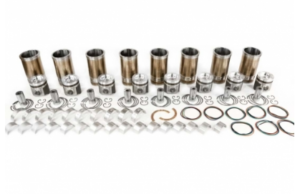August 18, 2025
What Is a Caterpillar Marine Engine Serial Number?
Why Caterpillar Uses Serial Numbers
What an ESN Can Tell You
Why the ESN Is Critical in Marine Applications
ESN and Arrangement Number: Working Together
Real-World Examples
Why ESNs Are Trusted in the Marine Industry
ESNs and Digital Support
The Bottom Line
What Is a Caterpillar Arrangement Number?
What the Arrangement Number Covers
Why Arrangement Numbers Matter
ESN and AN: Always Used Together
Working With Diesel Pro Power
The Bottom Line
Where to Find the Serial Number and Arrangement Number
3100 Series (3116, 3126)
3200 Series (3208)
3400 Series (3406, 3408, 3412)
3500 Series (3512, 3516, 3520)
Modern C-Series (C7, C18, C32, C280)
Caterpillar Marine Serial Number Prefix Reference
Work With Diesel Pro Power to Identify Your Engine
Final Thoughts
Read More
June 12, 2025
Introduction to the Caterpillar 3400 Series
Key Features of the 3400 Series Engine Family
Differences Between Original, B, C, and E Models
Base Models
B Models
C Models
E Models
Common Aftermarket Components
Engine Overhaul Kits
Cylinder Heads
Turbochargers
Fuel System Components
Cooling System Components
Gasket and Seal Sets
Oil Pumps and Lubrication Parts
Electrical and Sensor Systems
Unique Marine and Industrial Considerations
Marine Environments
Industrial Environments
Serial Nu
mber Reference for Parts Matching
Sourcing Reliable Aftermarket Parts
Warranty
OEM Match Quality
Technical Support and Expertise
Maintenance Best Practices
Fluid Analysis
Break-In Procedures
Scheduled Inspections
Rebuild vs. Replacement Strategy
FAQs About Caterpillar 3400 Series Aftermarket Parts
Conclusion
Read More
June 3, 2025
Adhering to Caterpillar’s Recommended Maintenance Intervals
Benefits of Routine Servicing for Reliability and Longevity
1. Enhanced Engine Longevity
2. Operational Reliability
3. Safety and Compliance
4. Cost Savings
5. Preserved Resale Value
OEM Disclaimer: Official Caterpillar Guidance is Essential
Final Thoughts: The Commitment to Excellence
Summary of Key Takeaways
The Ongoing Journey
Additional Resources
Read More
June 3, 2025
Introduction
Detailed Procedures for Priming the Fuel System on the Caterpillar 3208
Why Priming is Necessary
Tools and Materials Needed
Step-by-Step Priming Instructions
Best Practices
Step-by-Step Instructions for Coolant System Flushing and Cleaning
Why Flushing is Critical
Tools and Materials Needed
Flushing Procedure
Best Practices
Cleaning and Replacing Air Cleaner Elements with Proper Techniques
Why This Matters
Tools and Materials Needed
Cleaning and Replacement Procedure
Best Practices
Obtaining Engine Oil Samples for S.O.S. Analysis
Why S.O.S. Analysis is Critical
Tools and Materials Needed
Sampling Procedure
Best Practices
Conclusion
Additional Resources
Read More
June 3, 2025
Changing Coolant (ELC) at 216,000 Liters (57,000 US Gallons) or 6000 Service Hours or Every 4 Years
Why Coolant Change Matters for the Caterpillar 3208 Marine Engine
The Role of Coolant in Marine Diesel Engines
Understanding Extended Life Coolant (ELC)
What Is ELC?
Benefits of Using ELC in the Caterpillar 3208
Symptoms of Degraded Coolant
Required Tools and Materials
Step-by-Step Coolant Replacement Procedure
Step 1: Engine Cool Down and Safety Prep
Step 2: Drain the Old Coolant
Step 3: Inspect Components While Drained
Step 4: Optional – Flush the Cooling System
Step 5: Refill with ELC
Step 6: Bleed the System
Step 7: Dispose of Old Coolant
Post-Service Checks
Coolant Maintenance Tips Moving Forward
Maintain System Pressure
Inspect Heat Exchanger and Zinc Rods
Monitor Water Pump
Watch for Air Locks
Common Mistakes to Avoid
Signs It’s Time to Replace Coolant Even Sooner
Long-Term Cooling System Health Plan
Final Notes on Extended Interval Coolant Change for the Caterpillar 3208 Marine Engine
Disclaimer
Additional Resources
Read More

June 3, 2025
Comprehensive Inspection and Replacement of Key Engine Components
1. Cylinder Heads and Valves
2. Pistons, Rings, and Liners
3. Crankshaft and Bearings
4. Camshaft and Lifters
5. Turbocharger
6. Fuel Injection System
7. Cooling System Components
8. Lubrication System
9. Engine Mounts and Vibration Dampers
10. Gaskets and Seals
Recognizing Signs Indicating the Need for Overhaul
1. Increased Oil Consumption
2. Loss of Compression
3. Excessive Exhaust Smoke
4. High Blow-By Levels
5. Declining Performance
6. Unusual Noises
7. Contaminated Oil or Coolant
8. S·O·S Fluid Analysis Results
Recommendations for Pre-Failure vs. Post-Failure Overhauls
Pre-Failure Overhaul
Post-Failure Overhaul
Conclusion:
Caterpillar’s Official Guidelines and Use of OEM Parts
Why Follow OEM Guidelines?
Importance of OEM Parts
Summary and Final Recommendations
Additional Resources
Read More
Page 1 of 1812345...10...»Last »




 Free US Calls: 1-888-433-4735
Free US Calls: 1-888-433-4735 International: 305-545-5588
International: 305-545-5588

